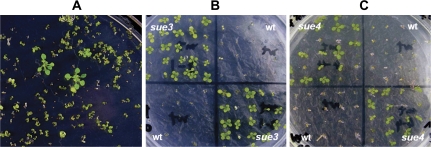Fig. 1.
Arabidopsis mutants with improved low-sulphur tolerance isolated with a high-throughput genetic screen. (A) Primary screen. Seeds from the activation-tagging library were germinated on sulphur-free medium as described in the Materials and methods. Three putative mutants in the image taken at day 12 post-germination show continued growth as evidenced by 2–3 pairs of true leaves and long roots in contrast to the rest of the seedlings with arrested growth on the plate. (B) Secondary screen of sue3. To confirm the phenotype of the mutants from the primary screen, a secondary screen was conducted as described in the Materials and methods. The wild-type (wt) and the mutant seeds (sue3) were sown on sulphur-free medium. Continued growth was evident for the mutant. The image was recorded when seedlings were 10 d old. (C) Secondary screen of sue4. To confirm the phenotype of the mutants from the primary screen, a secondary screen was conducted as described in Materials and methods. The wildtype (wt) and the mutant seeds (sue4) were sown on sulphur-free medium. Continued growth was evident for the mutant. The image was recorded when seedlings were 10 d old. (This figure is available in colour at JXB online.)

